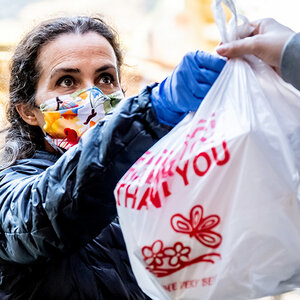Nonprofits, foundations adjust to the post-pandemic era

It has been three years since the world went into lockdown as a result of the coronavirus pandemic, and philanthropic and nonprofit organizations have emerged as significantly changed entities. But how much of the change is permanent, and how much will revert to the way things were before COVID-19?
At this point, it is hard to imagine jobs in the nonprofit sector without remote work, video conference calls with co-workers and clients, and even virtual fundraisers—all of which became commonplace as a result of office closures and the shuttering of direct service centers during the pandemic. Perhaps the most significant change to nonprofit operations was the willingness among foundations to provide general operating support and unrestricted funding during the crisis. While the flexible funding typically came from grantmakers who had previously supported the organization and knew its leaders and capacities, the change led to a dramatic shift that provided nonprofits the flexibility to address their most urgent needs at the time. According to Philanthropy and COVID-19: Examining two years of giving (50 pages PDF), a joint report from Candid, the Center for Disaster Philanthropy, and the Irene W. and C.B. Pennington Foundation, in 2020, 43 percent of COVID-related funding was unrestricted. That figure appears to have begun dropping the following year, however, as only 18 percent of coronavirus giving in 2021 was in the form of general operating support.
The report also found that the 2020 trend was driven in large part by billions in giving from Giving Pledge signatory MacKenzie Scott, whose outsized grants were mostly unrestricted. Still, when Scott’s gifts are excluded, 8 percent of dollars were awarded as general operating support in 2020; in 2021, the figure doubled to 16 percent.
The question remains whether foundations will continue to provide general operating support at these levels, a dream many in the nonprofit sector have held for decades. “Foundations have to make decisions based on their institutional values,” said Independent Sector (IS) president and CEO Akilah Watkins. “General operating support provides the sort of flexibility [nonprofits] can be more responsive with. And to be honest, it’s important for us to strengthen our institutions. General operating support does that.”
...it’s important for us to strengthen our institutions. General operating support does that.
— Akilah Watkins
Independent Sector
Libbie Landles-Cobb, a partner in Bridgespan’s San Francisco office, said the willingness of foundations to increase flexible funding during the pandemic has emboldened nonprofit leaders to have more honest conversations with funders. “Whether it’s about overhead, whether it’s about salary...[they’re talking about] the true cost of delivering things,” she said.
Delivering nonprofit services was especially critical during 2020, when potential exposure to COVID led to facemask requirements for many public and private functions, social distancing practices in organizations that were able to remain open, and the very real fear of contracting a potentially fatal disease from those people nonprofits were trying to help. “On the strategy and program delivery side of things, obviously the need grew immensely,” Landles-Cobb recalled. “Funding opportunities actually grew in many places, although many of those were temporary. We’re in a little bit of a decline from those funding sources right now. The need, though, has not subsided, and in many cases has worsened. Right now, nonprofits are very stretched both operationally and strategically.”
Faced with unforeseen challenges and increased needs, the sector has also seen a significant amount of innovation, said Landles-Cobb, some of which she believes will remain. Some of the innovations include nonprofits adapting their fundraising tactics, training practices, benefit offerings to employees, and more widespread use of communication technologies. “We’re definitely in a time right now of strategic refocusing....We’re just in a place that’s going to make organizations look different.”
Like any period of innovation, some of that stretching may ultimately be good for nonprofits, Landles-Cobb suggested. One of her clients in the field of afterschool educational programming, for example, explained that it now had an online solution for tutoring, which enables the organization to expand its reach and help children maintain continuity in school.
The ‘Great Exhaustion’
Despite such innovations, the sector faces the continued and increasing need to address challenges that the pandemic exacerbated. “The COVID-19 pandemic has really worsened a preexisting crisis of well-being in the social sector,” said Hannah Martin, a policy analyst at the Urban Institute’s Center on Nonprofits and Philanthropy. “People in the social sector are exhausted, suffer from low morale, and are overworked, and this has only gotten worse since the COVID-19 pandemic began.”
According to the Urban Institute, burnout from an array of factors including overwhelming demand for services, insufficient staffing, and inadequate compensation is causing nonprofit workers to leave the sector, which is resulting in staffing shortages and service cuts. “[T]he COVID-19 pandemic has reshaped people’s priorities around their work-life balance and led to an increased focus on well-being in care,” Martin added. “What we’re hearing is that people are increasingly rejecting the narrative that workers in the sector are supposed to ‘bleed for the cause.’ [Instead,] they’re looking for better wages, benefits, advancement opportunities, and diverse and equitable workplaces, and sometimes turning to unions as vehicles to get those things.”
“I’m very much still deep in the Great Exhaustion or Great Resignation,” said Landles-Cobb. “I don’t talk to a CEO any week who isn’t having people leave and having trouble filling those roles.”
People in the social sector are exhausted, suffer from low morale, and are overworked, and this has only gotten worse since the COVID-19 pandemic began.
— Hannah Martin
Urban Institute
Watkins described the exhausted workforce as a fundamental change to the sector. “We had a lot of paid [staff] and unpaid volunteers on the front lines working around the clock.”
While COVID was exhausting for everyone, for those on the front lines, the stress was palpable and ever-present. “People don’t think about their own mortality on a consistent basis, the way we did for two years,” said Watkins. “People are both psychologically and physically exhausted. I think there’s a toll to that.”
While a shift to remote work has helped some adapt, it has been a double-edged sword, Martin noted. For those nonprofits in which working remotely was an option for staff, some workers thrived, but some of their colleagues felt isolated. For many service organizations, remote work wasn’t feasible. Moreover, the exhaustion both remote and on-site workers experienced led many to complain of short attention spans, higher emotional volatility, and trouble making decisions.
“I think some people view the shift to more remote work as a benefit,” said Martin. “Just the ability for people to work remotely when they might not have been able to in the past can increase work-life balance for people and also increase accessibility for people with disabilities who might not have had the opportunity to work if not for working remotely....[For example,] I wouldn’t be able to work for an organization like the Urban Institute in D.C. from Indiana if not for remote work. But then we also did hear…concerns about access to broadband and different internet and technology services and the shift to more virtual things like remote work has actually isolated people.”
To improve workplace and working conditions, nonprofits have to incorporate the boldness they’ve developed, Landles-Cobb argued, including “being more proactive about advocating with their funders...and having more proactive conversations around compensation.”
Disruptions to giving and volunteering
But the financial and fundraising environment has also changed—perhaps more rapidly than ever before. The Urban Institute’s 2021 report Nonprofit Trends and Impacts 2021 (95 pages, PDF) found that 40 percent of organizations reported losses in total revenue in 2020, including 54 percent of arts organizations and 36 percent of all other nonprofits. According to the report, “Organizations that reported losses lost an average of 31 percent of total revenue and 7 percent of their paid staff by the end of the year. Moreover, the COVID-19 pandemic disrupted nonprofit services across the country, which led to a dramatic decline in program-related income.”
“COVID really caused a major disruption in nonprofits, finances, and their human resources, at least during the first year of the pandemic,” said Faith Mitchell, an Urban Institute fellow working with the Center on Nonprofits and Philanthropy and the Health Policy Center. “In terms of finances, we found that nonprofits experienced decreases in donations from individuals—more decreases in 2020 than in the preceding five-year period—and that from 2019 to 2020, nonprofits with fee-for-service revenue saw this revenue declined by a median of 30 percent.” Among arts nonprofits, the median decline in revenue was 50 percent, Mitchell added.
While the percentage of Americans who gave to charity rebounded in 2021, volunteering numbers continued to fall. A survey conducted by Gallup in December 2021 of 811 adults nationwide found that the percentage of respondents who reported volunteering their time fell to 56 percent in 2021, continuing a downward trend from 65 percent in 2013, 64 percent in 2017, and 58 percent in 2020.
“In terms of human resources, from 2019 to 2020, nonprofits lost an average of 7 percent of their part-time staff and 33 percent of their volunteers,” she said. “And in rural areas, this decline in volunteers was especially pronounced.”
Looking at 2023, nonprofits have tempered their fundraising expectations. According to the Nonprofit Alliance’s 2022-2023 ADRFCO Survey: Compiling Insights into the Nonprofit Sector, 65.64 percent of respondents indicated that their nonprofit clients met or exceeded projections for 2022, 68.75 percent said the results fell short of 2021 outcomes, and 43.75 percent said their clients have lowered their expectations further for 2023. Their concerns have little to do with COVID; rather, the biggest fundraising challenges they believed their clients would face in 2023 were inflation (84.85 percent), new donor acquisition (78.79 percent), and donor retention (63.64 percent).
Finding a balance
The pandemic resulted in the loss of more than 1.6 million jobs in the U.S. nonprofit sector, IS’s Watkins noted. “A vast majority of these jobs are held by women and especially people of color.” Roughly two-thirds of nonprofit workers identify as women. Although the sector has begun to recover, she said, “[w]hat we are seeing is that our sector isn’t recovering in terms of sort of racial equity in the same way. It’s getting less diverse in the sector.”
Landles-Cobb said that from her recent experience, members of nonprofit boards are increasingly looking to hire leaders from diverse backgrounds and focus on diversity and equity, particularly after the racial reckoning that arose after the murder of George Floyd in the spring of 2020. She believes the percentage of people of color holding CEO-level positions in the sector has significantly increased since 2020. While that would be good news, she said, the jury is still out on whether nonprofits are making the necessary changes in their organizational cultures to make them great places to work for BIPOC individuals.
A great deal of departures in the wake of the pandemic were the result of people “right-sizing” the role of work in their lives, Watkins said. “Leaders have to adapt to that....People want to connect themselves to institutions that are aligned with their values. That wasn’t necessarily the case when I was younger in the sector.”
The Urban Institute’s Martin agreed. In the institute’s recently released studies of infrastructure groups in the wake of the pandemic, “[t]he shifting of people’s priorities around work-life balance was something that people brought up as a benefit,” she said. “People are really thinking about what matters to them and thinking about their health.”
For example, Landles-Cobb noted one manager who left an organization to start a dog-walking business. “That’s about going to find your joy and [taking a] 'life is short' mentality.”
For IS, the pandemic caused the organization to look more closely at its benefits, Watkins said. “We’re making sure that our staff are healthy, that they have medical [coverage], and that includes mental health services....I think we’re still trying to figure out [what] we want to adopt as part of the human experience of work....And leaders have to know how to manage and how to support their teams through this cultural shift that we’re in.”
The struggle continues
According to the Community Conversations Report from the United Way of Greater Los Angeles (UWGLA), many people—especially BIPOC families—are still struggling with the mental and physical health effects of the pandemic. Not only are the families dealing with the health effects of the pandemic—including the loss of loved ones—but also the historic levels of inflation and the potential for an economic recession. The keys for nonprofits to help address those issues, the report argues, include prioritizing stable, affordable housing; ensuring that everyone has the support they need to weather crises; and ensuring that society works to enable all people can build wealth and achieve prosperity.
“The pandemic state of emergency ends, but our commitment to supporting families and individuals experiencing the daily crisis of poverty must grow,” said UWGLA chief executive Elise Buik. “The experience with COVID-19 showed us that, together, we can help people stay in their homes and increase their stability. Our Community Conversations Report makes clear what our most vulnerable are asking for and shows how we can be more prepared the next time we have to face a major crisis so that we won’t ever again witness the horrific disproportionate effects the pandemic had on marginalized communities of color.”
According to Watkins, the pandemic brought the value of civil society to the forefront of American life and demonstrated the key role it plays. “This is one of these indelible moments of our lives,” she said of the pandemic. “When we think about how we pick the pieces up and [try to] make meaning out of the experience, it feels so painful....People have changed.”








